Attractions
Polska
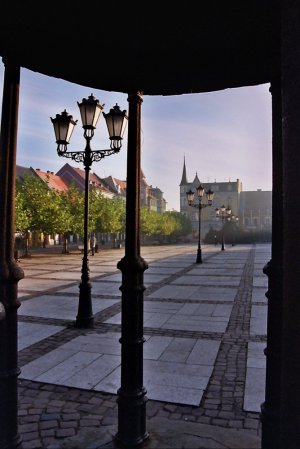
PSZCZYNA’S MARKET SQUARE
It is the central point of Pszczyna’s old town. While in Pszczyna it’s a must to visit the 18th century old town, which preserved a traditional middle aged layout. Several Coffee shops and Restaurants found on the Square draw with it’s unusual atmosphere. In the shade of the decorative plane trees you can enjoy an unforgettable moment and sit down on the Bench of Daisy. This is also the place of many artistic and cultural events.
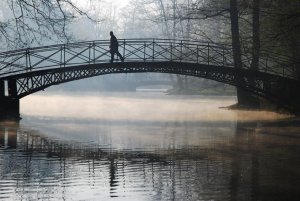
PSZCZYNA’S PARK
Walking from the Market Square in Pszczyna through the Gates of The Chosen Ones and further through the Castle courtyard one enters a 156 ha historic area of Pszczyna’s Park. Often visited by tourists throughout the whole year it attracts with diversity and richness. It was established in the 16th century, redesigned from a renaissance garden to a baroque style garden in the 18th century. The park’s present layout comes from the second half of the 19th century. The composition got attributes of a romantic garden using modern elements of those days: clusters of trees and shrubs, ponds, arch bridges over the channels, gazebos and different buildings. We can find here among others, the dukedom’s horse stable, ice-chamber, tea-house and the Chinese gates. In the western part of the park called the “game park”, in the picturesque surroundings lies the Golf Course. It is connected to the territory of the Bison Centre.
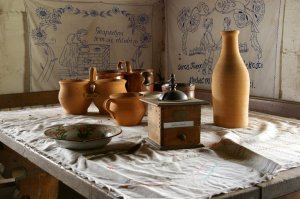
PSZCZYNA VILLAGE HERITAGE PARK
The Museum located in the eastern part of the park, is where one can see the most precious monuments of wooden rural architecture from the neighbouring villages. Since 1976 “Meetings under the Larch” , a folk culture festival, has been organised here. The events are attended by several dozen singing and music bands from the entire region. The event is accompanied by the folk artists fair which presents the preserved art of painting, embroidery and wood sculpturing.
Skansen „Zagroda Wsi Pszczyńskiej”; ul. Parkowa 20, 43-200 Pszczyna; tel. +48 32 210 57 77, +48 604 508 718; www.skansen.pszczyna.pl
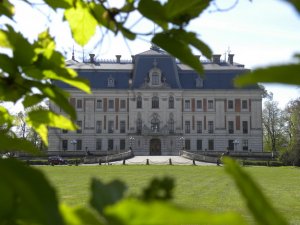
THE CASTLE MUSEUM IN PSZCZYNA
It is one of the most valuable resident-museums in the country. The building from the 14th century was rebuilt many times. Now we have here the Castle Museum, which shows historical interior from the breakthrough of the 19th and 20th century. In the museum collection, 70% of the preserved items are historical castle furnishings. At present available to view are the original living interior between the 19th and 20th century, apartments of Emperor Wilhelm II, The Miniatures Room, 15th century Gothic Basements and the armoury. This place allows the visitors to get to know the climate of the Baron’s residence.
Muzeum Zamkowe w Pszczynie, ul. Brama Wybrańców 1; 43-200 Pszczyna; tel. +48 32 210 30 37, +48 32 449 08 88; www.zamek-pszczyna.pl
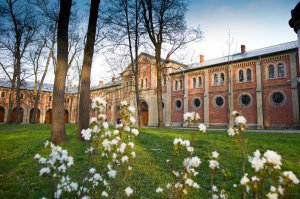
PRINCE’S HORSE STABLES IN PSZCZYNA
The Prince’s Horse Stables are situated nearby Pszczyna’s Castle, the first information about the stables comes from Pszczyna’s Urbarium from 1629. The existing complex of horse stables was erected in the 2nd half of the 19th-century during the time of the Hochbergs and according to the project of the architect Olivier Pavelt. This complex consists of: a carriage house built in 1864, stables with tack room built in 1866-1867, riding arena which was built from 1869 and masoned garages which were erected between 1904 and 1910 for nine Prince’s cars. Under the agreement between the Marshall of Silesia Province and the town of Pszczyna, it was decided to renovate the building in order to transfer it to the Castle Museum which took place on the 12th of July 2013.
Stajnie Książęce w Pszczynie; ul. Basztowa 6-8, 43-200 Pszczyna; tel. +48 32 211 90 56; www.stajnieksiazece.pl
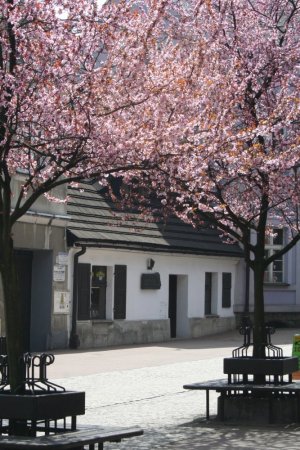
SILESIAN PRESS MUSEUM
The Museum situated on Piastowska street is the only one of it’s kind in Poland. In the 19th century Pszczyna became one of the most important printing centers in Upper Silesia. The museum exposition shows the history of Silesian Press from the beginning up to the year 1939. As the only museum it collects vintage printing machines and equipment. Inside is also Telemann’s Chamber- a music and poetry hall where besides the 18th century positive organ, are displayed collections of old musical instruments. The Silesian Press Museum bears the name of Wojciech Korfanty - leader of the Silesian people, and also creator of the most popular Polish news papers in Silesia. The museum is labelled on the trail of technical monuments and is one of more than thirty places on it’s route - the only such trail in Poland, belonging to the European Trail of Industrial Heritage.
Muzeum Prasy Śląskiej, Izba Telemanna; ul. Piastowska 26, 43-200 Pszczyna; tel. +48 32 210 22 13; www.muzeumprasy.pl
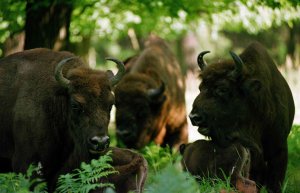
PSZCZYNA’S BISONS
Meeting eye-to-eye with the king of the backwoods is possible in two places in our district. The first place is the Ecological Education Center “Pszczyna’s Bisons” in Jankowice where you can follow in their tracks in an almost 10 ha reserve and get to know their natural environment. Several information boards placed on the path explains the life and the history of the Bisons and also explains the issues of the Forest Ranger’s work, ecology and nature conservation. For meeting a Bison you can also go to the Bison Center which is located near the Castle and the old town in the wild scenery of the game park. Strolling around on the platforms one can take a peek at the animals which are living in the pen and then visit the permanent exhibition dedicated to the history and breeding which one can find in the Education and Tourism building. Sightseeing those places will give one the knowledge about plants and animals of the old backwoods of Pszczyna.
Pokazowa Zagroda Żubrów; ul. Żorska 5, 43-200 Pszczyna; tel. +48 32 447 05 03; www.zubry.pszczyna.pl
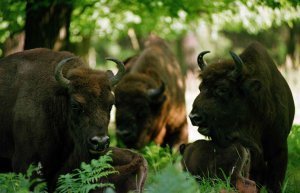
PSZCZYNA’S BISONS
Meeting eye-to-eye with the king of the backwoods is possible in two places in our district. The first place is the Ecological Education Center “Pszczyna’s Bisons” in Jankowice where you can follow in their tracks in an almost 10 ha reserve and get to know their natural environment. Several information boards placed on the path explains the life and the history of the Bisons and also explains the issues of the Forest Ranger’s work, ecology and nature conservation. For meeting a Bison you can also go to the Bison Center which is located near the Castle and the old town in the wild scenery of the game park. Strolling around on the platforms one can take a peek at the animals which are living in the pen and then visit the permanent exhibition dedicated to the history and breeding which one can find in the Education and Tourism building. Sightseeing those places will give one the knowledge about plants and animals of the old backwoods of Pszczyna.
Ośrodek Edukacji Ekologicznej „Pszczyńskie Żubry”; Jankowice, ul. Żubrów 151, tel. +48 32 211 54 06, +48 660 789 564, www.katowice.lasy.gov.pl/web/kobior/oee

GOCZAŁKOWICE LAKE
One of the greatest attractions of the regions is the reservoir on the Vistula River called Goczałkowice Lake and the ponds located in the Vistula Valley. The reservoir was built from 1950-1955 in the surroundings of rich nature and forests which were a part of the former backwoods of Pszczyna. It became the biggest reservoir in southern Poland. Besides supplying water its also serving as flood protection. The outstanding feature of the reservoir is also the richness of fauna and flora, including waterfowl.
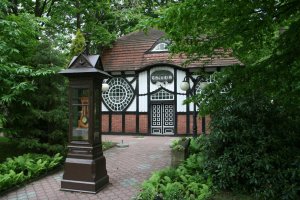
HEALTH RESORT IN GOCZAŁKOWICE – ZDRÓJ
The Health Resort was established in 1860 by a four person partnership after discovering a salt water spring. Today it is the County’s Rheumatology-Rehabilitation Center, based on huckleberry deposits and saltwater springs. What stands out in the Health Resort is an old pump room from the beginning of the 20th century. Here are the Rheumatology Hospital and the Rehabilitation Sanatorium for Children and Adults. The environment is for rehabilitation and treatment of musculoskeletal system diseases. It also offers salt rooms and cryotherapy. In the health resort there is a Pictoral Photo Gallery called „Weranda” (located at 54 Uzdrowiskowa Street), hosted by "Przeciw Nicości" – Mieczysław Wielomski Photographic Association. The Association promotes the beauty of the Polish landscape in the artistic photography, therefore Weranda holds numerous vernissages(private views) exhibitions and photo contests.
Uzdrowisko Goczałkowice-Zdrój; ul. Uzdrowiskowa 54, 43 – 230 Goczałkowice-Zdrój; tel. +48 32 449 20 00; www.gozdroj.pl
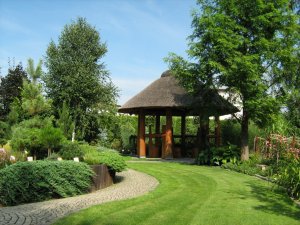
KAPIAS NURSERY GARDENS
The unique garden is divided into different kinds of alleys, among others a romantic, forest or mountain. For visitors the following gardens are available: english garden, village garden, garden of the sunsets, the rustling grass corner and the heath. The entire Nursery is accessible free of charge- from middle April to the end of October and is accessible for disabled people. Furthermore, an educational footpath with the theme ”Garden and its importance in our life”. Cyclical events are organized throughout the year in the garden territory , a few of which are: “Garden Open Days”(May), “Green Holiday” (July) and “Colours of September” (September).
Ogrody do Zwiedzania; ul. św. Anny 4, 43–230 Goczałkowice-Zdrój; tel. +48 667 777 292; +48 667 777 084; www.kapias.pl
ST CATHERINE CHURCH IN PIELGRZYMOWICE
A wooden church, erected in 1675-1680 on the site of the former temple. Extended in 1908-1911. In the vicinity there is a former organist house, the birthplace of Karol Miarka, a leading national activist in Upper Silesia in the mid-19th century. The church interior, lit by a significant number of windows, is spacious and light. It was added an aisle which is not typical in the region. The interior is decorated with paintings displaying folk features. The most outstanding part is the Baroque side altar with an oil painting of the Holy Trinity (18th-century) and the Baroque pulpit with an interesting relief depicting the Heavenly Father.
Rzymskokatolicka Parafia św. Katarzyny; ul. Karola Miarki 6, 43-253 Pielgrzymowice; tel. +48 32 723 30 82; www.pielgrzymowice.parafia.info.pl

GATE OF THE CHOSEN ONES
The oldest (1687) part of the castle complex in Pszczyna which is preserved till today in it’s original form. At the gate there were rooms for castle guards which were chosen from the local peasants and hence the name the “Chosen Ones”. At present in this site there is a Tourist Information Office.
Pszczyna, ul. Brama Wybrańców 1.
PRIVATE COLLECTIONS
Thanks to the passion for collections of the residents of the district, there were a few private collections created here. Both the privately-owned Szendera Family collection and Tadeusz Żyła collection and the Regional Museum “Smolarnia”, contains exhibits reminding of old life in the region of Pszczyna.
Muzeum Regionalne „Smolarnia”, Kobiór, ul. Zmienna 36, tel. +48 32 218 83 78
Prywatna kolekcja zabytkowych narzędzi rolniczych Państwa Szenderów, Suszec, Kolonia Podlesie 5, tel. +48 32 212 42 48
Prywatna kolekcja zabytkowego sprzętu domowego, narzędzi rolniczych oraz broni historycznej Pana Tadeusza Żyły, Jankowice k/ Pszczyny, ul. Szewczyka 3a, tel. +48 32 211 50 14, +48 601 493 399
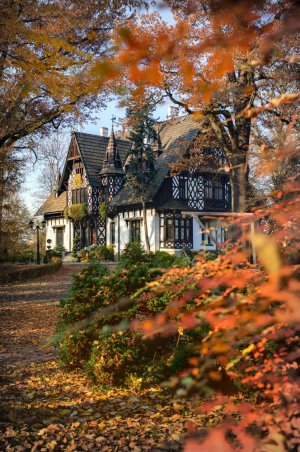
HUNTER’S LODGE IN PROMNICE
The Neo-Gothic Hunter’s Lodge next to the artificial Paprocany Lake was built in 1861 by Jan Henryk XI as a place for hunting and recreation. It is connected to the Castle in Pszczyna by means of a historical oak path. From 2018, the palace is a part of the Castle Museum in Pszczyna.
Hotel „Noma Residence”; Kobiór, tel. +48 32 219 46 78; www.promnice.com.pl
SILESIAN MILITARY HISTORY MUSEUM IN PSZCZYNA
The Silesian Military History Museum has its office in main office in the neo-gothic “Gardener’s House” at ul. Katowicka 1 in Pszczyna. There are souvenirs associated with the Silesian Uprisings and the martyrdom of Silesia, especially from the Second World War and the fighting against the Polish independent underground, after the war. Exhibitions inside the museum include weapons, ammunition, uniforms, documents, photographs, maps and paintings. In the adjacent garden to the “Gardener’s House”, one can become acquainted with the outdoor exhibition, where reconstructions of siege machines, a Hussite wagon, as well as a lapidarium commemorating Silesian places of glory can be found. The museum is ran by „Pro Memoria. Pszczyna Battle Association of 1939”.
Muzeum jest prowadzone przez „Pro Memoria. Stowarzyszenie Bitwy pod Pszczyną 1939”. Muzeum Militarnych Dziejów Śląska w Pszczynie; ul. Katowicka 1, 43-200 Pszczyna; tel. +48 79 55 747 40; www.militaria.pszczyna.pl
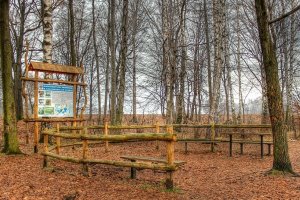
DIDACTIC NATURE PATH IN GOCZAŁKOWICE – ZDRÓJ
It’s route runs through the area of the former backwoods of Pszczyna, and its under the special protection of the Nature 2000 program. Its about 3 km long and its composed of 4 sections with different environmental values. The path starts at the railway station in Goczałkowice - Zdrój, runs down the alley along “Maciek” pond (section I), further down the oak alley along the forest (section II) and down the road between “Zabrzeszczak” pond and the mixed coniferous forest (section III). The last section at the Vistula river oxbow is a charming spot of Pszczyna’s region.
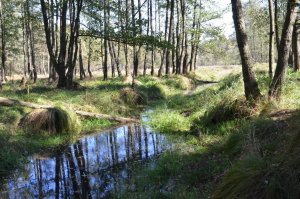
BABCZYNA VALLEY
In the Forest District of Kobiór, there is a nature reserve called Babczyna Valley which protects Calamagrostio villosae-Pinetum together with many species of bryophytes and tracheophytes. Korzeniec Valley is one of the attractions of the educational nature path, which extends a few kilometers inside the forest. Babczyna Valley stretches down forest routes and narrow paths lined with few hundred-year old oaks planted by the duke of Pszczyna. The reserve was created in 2002 and covers 80 ha. Next to the most important spots of the nature path are observation points and information boards describing local fauna and flora in detail.

PEAT BOG “ZAPADŻ”
The peat bog “Zapadź” is located in Miedźna borough territory, close to the Vistula river. Most probably it is an excavation after clay or loam deposits. It covers about 19 ha. Similar areas like the peat bog “Zapadź” are very rare in the whole of Silesia. The progression of urbanization, industrialization and drainage cause areas like these to vanish. At the peat bogs are rare and protected plants growing and the diversity of species is always bigger that of other places. Besides plants, many rare and protected animals connected to marsh, water and peat bog habitat, live here. Enriching the landscape, peat bogs are also a kind of reservoir receiving excess water during periods of heavy rain and releases the water during rainless periods.
ST JAMES THE GREATER CHURCH IN WISŁA MAŁA
It dates back to 1775 (church) and 1782 (tower). The church is surrounded with arcades which are half-closed with horizontal planks. The interior is kept Baroque. The characteristic feature is a matroneum located on the western wall of the nave which reaches the inside of the tower, a large part of which has been incorporated into the nave. The church interior is preserved in a single style. The main altar, three side altars, pulpit, confessional and baptismal font with an image of an Angel go back to the 18th century. Special attention should be paid to the main altar decorated with painted carvings depicting among others, the saints Andrew and Peter. The main altar has a painting of the church’s patron saint. The pulpit is a precious monument. It’s balustrade presents a painting depicting the “ Jacob’s Dream”.
Parafia św. Jakuba Starszego Apostoła w Wiśle Małej; ul. Pawia 13; 43-243 Wisła Mała; tel. +48 32 212 31 01; www.jakubstarszy.pl
ST MARTIN CHURCH IN ĆWIKLICE
The temple goes back to the turn of the 17th century. The walls are covered with, among others, 18th-century paintings. It is worth studying the 18th-century Baroque altars, the Rococo pulpit and baptismal bowl. The main altar is decorated with painted carvings and a 17th-century painting of the patron saint of the church, St Martin. In the chapel annexe added to the nave, is a invaluable painted triptych depicting the Virgin Mary with Child and the saints Stanislaus and Martin. The chapel is accessed through the 16th-century oakwood door decorated with ferrules, preserved from the old church.
Parafia św. Marcina w Ćwiklicach; ul. gen. Zawadzkiego 9, 43-229 Ćwiklice; tel. +48 32 211 21 94; www.marcin-cwiklice.pl

ST NICHOLAS CHURCH IN ŁĄKA
The temple was built in the 17th century. Its outstanding feature is an independent tower situated to the east of the church. This bell tower is one of the most valuable monuments of sacred architecture in Silesia. The tower houses a historical 15th-century bell. It is worth standing for a while in front of the Baroque main altar with the oil painting depicting St Nicholas, the bishop of Mira.
Parafia św. Mikołaja w Łące; ul. Dygasińskiego 3, 43-241 Łąka; tel. +48 32 447 85 60; www.parmikolaj.katowice.opoka.org.pl
ST JOHN THE BAPTIST CHURCH IN GRZAWA
The temple was built in the early 16th-century. This is one of the most valuable sacred wooden buildings in Pszczyna region, and one of the most valuable ones in silesia. The main altar, with the painting of the head of St John the Baptist, is decorated with carvings. On the altar’s sides there are traditional “gates” for offerings. Both the main altar and the sides ones, pulpit and beautiful positive organ, were made in the style of folk baroque.
Parafia św. Jana Chrzciciela w Grzawie; ul. Kościelna 1, 43-227 Grzawa; tel. +48 32 211 63 11; www.parafiagrzawa.pl
ST CLEMENT CHURCH IN MIEDŹNA
Built in the 17th century, it is the greatest wooden temple in the district of Pszczyna. It is made of logs with the traditional wall reinforcement carried out by the so-called “soboty” and “lisice”. It was cladded with timber and covered with shingles. Above the nave there is a ave-bell turret placed with a Baroque lantern. In the west the nave connects with a tower topped with the so-called “izbica” (the highest floor of a wooden tower) and bulbous cupola with a lantern. The interior has rich Baroque decorations (among others the main panel altar with gates and the patron’s pew from the 18th century). Behind the altar, there is a reproduction of a small stained-glass window from the 15th century.
Parafia pw. św. Klemensa w Miedźnej; ul. Wiejska 47, 43-227 Miedźna; tel. +48 32 211 61 23; www.miedzna.wiara.org.pl
ST BARBARA CHURCH IN GÓRA
The temple was probably erected in the 16th century. One of its distinct features is a three-sided chancel. Originally, the church was a chapel and only in 1950 it was extended to the present size. The temple was made of logs and the walls were reinforced using the traditional solution called “lisice”. The church roof is covered with shingles and the church body is surrounded with the so-called “soboty” A turret, embedded in the church body and covered with a multi-hipped roof, overlooks the church from the west.
Parafia św. Barbary w Górze; ul. Topolowa 37, 43-227 Miedźna; tel. +48 32 211 71 71
THREE OAKS
The “Three Oaks” glade is one of many places to remember in Pszczyna. It stretches into the wild, western part of the castle park, near the Bison Retreat. It owes its name to the once-magnificent oaks which grew here. By the end of the 1910’s, nothing could have foreseen the tragic future of this place. In the summer of 1919, the area was pulsing with the hope that the men from Pszczyna and neighbouring towns were full of, coming to the seclusion to take an insurrectionary oath. In August, they set out to fight for the connection of this part of Silesia to the newly-reborn Polish state. While the first uprising was lost, two more, along with a plebiscite, came later on which decided that the insurrection’s dreams were fulfilled. In 2009, the area was cleaned up and made into a war cemetery called “Under Three Oaks”. In the park near the cemetery, it’s worth looking for a reconstructed wooden war shelter - just like the one that served the Polish Army in 1939.
Źródło: www.slaskie.travel
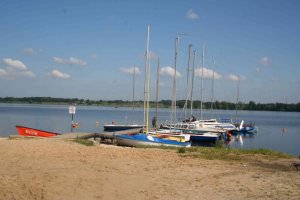
WATER SPORTS CENTER IN ŁĄKA
The resort has a beach with a private bathing area, football and beach volleyball courts, a marina for boats and yachts, a catering point and places for a bonfire or barbeque. It is possible to pitch a tent or set up a caravan. There are well-equipped sanitary facilities available for campers. You can rent water equipment: water bikes, kayaks, windsurfing boards or even boats and yachts.
Ośrodek Sportów Wodnych; ul. Piotra Skargi 44, 43-241 Łąka; tel. +48 664 748 104; www.osw.moris.pszczyna.pl
(opening hours: 9:00 - 19:00, from May 1st to September 30th).
PTTK YACHT CLUB PSZCZYNA IN WISŁA WIELKA
PTTK Pszczyna was founded on the 5th of February 1960. The club is currently formed of approx. 40 members, with the group changing every so often. Every year, courses and training sessions are organised for sailors and yacht helmsmen and are attended annually by about 20 people, including a group of 14-18 year olds. The club currently has: two yacht captains, two ocean yacht helmsmen and dozens of helmsmen and yachtsmen. For many years, sailing training organised in the club has been run by its own team of instructors, currently composed of 6 people. Up until 2010, PTTK Pszczyna conducted its activities on the Łąka lagoon, Masurian lakes and sea areas (Baltics, North Sea, Adriatic). In August 2010, the long-awaited opening of Goczałkowice Lake to sailing took place. Club yachts could finally return to the waters of this magnificent lake.
Jachtklub PTTK Pszczyna; ul. Dębowa 5, 43-243 Wisła Wielka; tel. (Duty Officer: +48 579 637 840 - open during port hours from 10.00 to 19.00; off-season contact by phone.: +48 32 210 35 30); jachtklub-pszczyna.pl
ECO CENTER IN GOCZAŁKOWICE-ZDRÓJ
The Eco Center was made within the framework of the project: Creation of an EcoEnergy Technology Park - Water - Safety seated in Katowice and the Field Research Center in Goczałkowice-Zdrój. It is located on the Goczałkowicki Lake near the dam, neighbouring the largest water treatment plant in the south of Poland. The attractive surroundings include: the Fish Farm in Łąka and Yacht Port in Wisła Wielka. The Eco Center's activities include: organisation of scientific conferences, training for children and youth in the field of ecology, conducting research in the field of hydrological and flood safety, raising ecological awareness - NATURA 2000, conducting scientific research in the field of safety of drinking water intakes and conducting research in the field of fish stocks in the reservoir.
Centrum Badawczo-Edukacyjne Ekocentrum; ul. Jeziorna 87, 43-230 Goczałkowice-Zdrój; tel. +48 32 220 80 71, +48 604 301 632; www.ekoenergiasilesia.pl
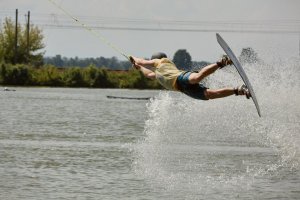
WAKE PARK IN GOCZAŁKOWICE-ZDRÓJ
Adrenaline seekers can try their hand at the ski lift or skimboard. There are two types of lifts, 180 and 200 meters long, with obstacles. The organisers also encourage stand up paddleboarding. Stand up paddleboarding is nothing but rowing while standing. It’s an innovative way of spending free time by the water. It consists of combining a traditional surfboard with an oar. The advantage of stand up paddling is the lack of age restrictions and physical fitness of users. For the others, Wake Park offers yoga classes and the possibility to rent kayaks or pedalos. Occasional concerts add to the attractions. There is also a small playground for children at Wake Park.
Wake Park; ul. Uzdrowiskowa 88, 43-230 Goczałkowice-Zdrój; tel. +48 784 784 441; www.wakego.pl
CITY PARK IN STRUMIEŃ
An ornament of little Strumień, located to the north of Cieszyn Silesia, there are interesting monuments with a baroque town hall and a nice park in which - by sitting down by the fountain - you can take a deep breath of healthy sea air, and, if the opportunity arises - participate in one of the many cultural or sports events here. There is also a memorial to the victims of the Death March of the Auschwitz-Birkenau prisoners in the park.
TOWN HALL IN STRUMIEŃ, GALLERY UNDER TOWN HALL
The Town Hall, being the seat of the authorities in Strumień, is from 1628. Located in the renovated basement of Strumień Town Hall is Gallery under Town Hall. Exhibition areas and extensive facilities were developed in 2009-2011 as a result of Polish-Slovak cooperation. The gallery is an place for exhibitions, vernissages and meetings. The works presented her are from both local and foreign artists. Gallery under Town Hall is open in the working hours of Town Hall. Organised groups can arrange with the Promotion and Development Office via phone: +48 33 8570 182 or +48 781 727 772.
Urząd Miejski w Strumieniu; ul. Rynek 4, 43-246 Strumień; tel. +48 33 85 70 142; www.strumien.pl
ST. BARBARA SANCTUARY IN STRUMIEŃ
St. Barbara’s Church in Strumień is a typical, late-baroque building erected at the end of the 18th century. Its founders were the then-owners of Cieszyn Silesia, ie. Prince Albert Kazimierz and his wife, Maria Krystyna. From the outside, the temple is dominated by a tower with a bulbous helmet, and while inside, it’s worth paying attention to the late-baroque altars and a stain-glass window with the figure of Mikołaj Brodecki, the town’s founder.
Parafia Rzymsko – Katolicka Św. Barbary; ul.1 maja 9, 43 -246 Strumień; tel. +48 33 857 01 46; http://strumien.duszpasterstwa.bielsko.pl/
MUNICIPAL CENTER OF CULTURE AND RECREATION, MEMORIAL ROOM
The main objective of the cultural activities of the Municipal Center of Culture is to recognise and stimulate the cultural needs of the surroundings, shaping examples of active participation in culture, conducting various forms of cultural education, taking place throughout the area and equalising opportunities for access to culture through seven clubs. There are multiple sections operating in the center, including: artistic, dance, photographic and instrumental. There is a strong working environment of artists, singers, musicians, poets and handcrafters. Costume rental has been operating here for a few years. Performers from all over the world perform on the stage of the cultural center. In the center, there is also a Memorial Room, with valuable props and souvenirs.
Miejsko-Gminny Ośrodek Kultury; ul. Młyńska 14, 43-246 Strumień; tel. +48 33 8570 174; www.emgok.pl
PALACE IN ZEBRZYDOWICE
The palace in Zebrzydowice is a building with a slim, compact body which has had its current form as a result of a reconstruction which was carried out in the 18th century. It first served as a defensive structure, which - erected in the Middle Ages - probably had the character of a Gothic castle at the time. The residence, which had its form thoroughly changed over the years, suffered significantly in the post-war period. Currently located inside the palace is GOK and several other institutions.
Pałac w Zebrzydowicach; ul. Ks. Antoniego Janusza 21, 43-410 Zebrzydowice; tel.: +48 32 469 33 34
AGROTOURISM FARM IN PRUCHNA
The farm can be found in a small, calm village in the Podbeskidzie area. The house is located off the beaten track in a picturesque area, surrounded by forestry and ponds. The property is surrounded by several hundred year-old oaks, which adds a certain charm. The farm specialises in breeding freshwater fish - carp, grass carp, silver carp, tench, Prussian carp, northern pike, zander and catfish. The fish are bed in an ecological way - only on natural food such as wheat seeds.
Gospodarstwo agroturystyczne WODNA DOLINA; ul. Cicha 28, 43-523 Pruchna; tel. +48 606 490 731, +48 694 884 868; www.wodna.dolina.ox.pl
EFFATA PARISH CENTER IN DROGOMYŚL
In the center’s building is a parish office (Evangelical Lutheran parish in Drogomyśl) and multifunctional hall that can accommodate up to 150 people - it’s a good place for worship services, but also for lectures or presentations. A part of the café allows for the organisation of social meetings or pleasant conversations after the service. A diakonia station is on the ground floor. There is a physiotherapy room, a doctor’s office and a waiting room. The new area had allowed for the introduction of new Deacons’ operations. The beauty of the nearby complex in Drogomyśl, Gołysz and Ochaby makes it worth visiting.
Kancelaria Parafiala w Drogomyślu; tel. +48 33 857 21 23 w.21; www.drogomysl.luteranie.pl
„ROTUZ” RESERVE IN CHYBIE
The reserve was created on the grounds of an ordinance of the Minister of Forestry and Wood Industry, dated December 30, 1966. Within the reserve, the whole complex of peat-forming communities is protected, in which the transitional peat bog plays the biggest role. However, its important component is also the vegetation of raised bogs and low-peat bogs. There are also forest communities in the reserve, just like the bog itself is strongly dependent on water management in the ground. They are mostly pine forests: marshland and damp forest, which create the natural environment of peatlands. The reserve is part of a vast forest complex with an area of more than 1000 hectares, located between Chybie to the west and Zabrzeg to the east. More than 77 species of vascular plants, 68 species of mosses and 19 species of liverworts were found in the “Rotuz” reserve.
GOŁYSKA MOTHER OF GOD SANCTUARY – CHURCH OF CHRIST THE KING IN CHYBIE
The church in Chybie was built between the wars. A temple with interesting architecture, with an interesting fancy façade was built according to plans made by Henryk Szołdr, with the interior being arranged under the direction of the well-known Istebna painter, Jan Wałach. The church is a Marian sanctuary. Since the 1950s, there has been a painting of the Mother of God, famous for graces, brought from the chapel in Gołysz which was taken down in connection with the construction of the Goczałkowice reservoir.
Rzymskokatolicka Parafia p.w. Chrystusa Króla/Sanktuarium Matki Boskiej Gołyskiej; ul. Wyzwolenia 2, 43-520 Chybie; tel. +48 33 856 10 10; www.parafia-chybie.pl
MNICH VINEYARD
Mnich Vineyard was founded in 2006. The history of the vineyard actually starts with the buying of a declining, 3-hectare farm with a beautiful old orchard and, of course, a love of wine. Mnich Vineyard is the largest vineyard in Silesia, with 2.5 hectares. Various grape varieties (18 varieties) are grown here. Wine production is carried out using traditional methods. Wines which are produced here are both white and red, half-sweet and dry. Degustations are ran in connection with tours of the vineyard. It is also possible to organise integrational parties, picnics, training courses, artistic workshops for children and adults, open-air painting and cultivational training.
Winnica Mnich; ul. Świerkowa 19, 43-520 Mnich (gmina Chybie); tel.: +48 601 974 006, +48 506 132 598; www.winnicamnich.pl
Czechy
FRYŠTÁT CASTLE, CASTLE PARK - KARVINÁ
Fryštát Castle is the dominating point of Karviná. It’s an important cultural monument - the only one which survived. There is no precise information when it was built, but according to documents, it was already standing in the 13th and 14th century. The history of the castle is, above all else, connected with its founders - the royal family of the Piasts of Cieszyn and the last owners of the castle, the Count of Larisch-Mönnich, who had a significant position at the Imperial Court, becoming friends with Empress Elizabeth called “Sissi”. Since 1997, the castle has been made available to visitors, following extensive reconstruction. The castle has one of the most important castle libraries and an important collection of hand-woven French carpets from the 18th century.
Zámek Fryštát; Masarykovo nám. 1, 733 01 Karviná; tel. +420 596 387 340; www.zamek-frystat.cz
DARKOV SPA RESORT - KARVINÁ
Darkov Spa Resort is composed of two health centers: Darkov Medical Center in Karviná – Darkov Spa and Rehabilitation Sanatorium in Karviná-Hranice. The first mention of natural healing water is from the 13th century but the spa was not established until 1866. Today, the spa is visited not only by patients for convalescence, but also by private individuals.
Lázně Darkov; Československé armády 2954/2, 733 12 Karviná – Hranice; tel. +420 596 372 211; www.darkov.cz
SOKOLOVSKY’S BRIDGE OF HEROES (DARKOVSKI BRIDGE) - KARVINÁ
The main historical significance of this bridge was the connection of the Olza river with the divided Darkov, with cars being able to cross the bridge. It was damaged by floods in 1997 but repaired in subsequent years. Cars have not been able to cross the bridge since 2004 and it is currently listed as an architectural monument.
BOATING LAKE - KARVINÁ
The Boating Lake can be found in the blind shoulder of the Olza river, in the southern part of Castle Park (Boženy Němcová Park). Due to the concept and location, it is a natural recreational area for city residents and visitors. The extensive reconstruction of the boat marina, snack bar and boat warehouse were completed in 2011. A large fireplace with seating are available under the roofed terrace. Visitors can also actively spend their free time or relax, thanks to the various sports pitches and many places to rest, including the possibility of a boat trip. Just like in other parts of the Olza river, it’s possible to go fishing here.
STONAVA ADVENTURE GOLF
Next to the PZKO House (Polish Cultural and Educational Union) a new, modern gold course has been opened. Visitors can play an emotional round of mini golf in the summer. The course is shaped like a normal golf course and can be walked around. Adventure gold has been operating since 2016.
Adventure golf Stonava; Stonava, 735 34 Stonava; tel. +420 776 032 441; www.stonavska.com
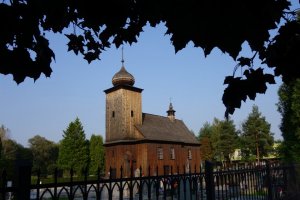
ST. PETER AND PAUL’S WOODEN CHURCH - ALBRECHTICE
The baroque, wooden, single-nave church was originally dedicated to Archangel Michael, currently St. Peter and Paul, and since 1766, it has a four-sided entrance tower finished with an onion-shaped tin dome. It was built out of massive oak logs lined with fir boards with a shingle roof. The church’s interior is characterised by a flat ceiling. It belongs to typical Beskid religious buildings. The church is located at the local cemetery - carefully maintained and interestingly arranged. The church was created to replace the wooden original, which was destroyed as a result of the nearby Stonava river overflowing. It doesn’t have a regular liturgical function; this function was taken over by a brick church from 1938. It is currently protected as an architectural monument. Following extensive reconstruction in 2008, the church obtained its “old-renovated” face.
Kostel Sv.Petra a Pavla; Školní 812, 735 43 Albrechtice; Prohlídku lze domluvit na obecním úřadě na tel. +420 596 428 448
FLOODGATE - TĚRLICKO
Těrlicko’s water reservoir is located on the Stonávka river among the picturesque hills of the Cieszyn region. The floodgate was completed in 1963. The water surface covers 277 ha and is 23.4m at its deepest. The dam is 30.4 meters high and 617 meters long. At first, the floodgate was built as a place to supply water for the Karviná mine and the smelting mill. Today, it serves mainly as a summer recreation center for the area. It also serves for flood protection.
ŽIVOTICKÁ TRAGEDY MONUMENT - HAVÍŘOV
The monument is a symbol of the suffering and struggle of the Cieszyn region’s people during World War II. Its author was an academic sculptor - Franciszek Świder from Karviná. The monument was unveiled on the fifth anniversary of the Životická Tragedia in 1949. It commemorates the event which took place on the 6th of August 1944. Members of the Cieszyn and Katowice Gestapo, accompanied by German military police, arrested residents who could not prove they were of German heritage. In total, 36 men from Životice and the surrounding villages (including 28 Poles and 8 Czechs), without questioning, were shot near their homes. The reasoning behind the liquidation was a shooting in a Životická public house. In 1984, a modern building was built near the monument, which is currently a branch of The Cieszyn Museum in Czech Cieszyn.
Památník Životické tragédie; Padlých hrdinů 220/47, 736 01 Havířov-Životice; tel. +420 596 434 138; www.muzeumct.cz/zivotice
TĚRLICKO SQUARE
The newly renovated, picturesque square is the seat of important buildings and places. Other than the usual shops (pharmacy, grocery shop, butcher etc.), there is Svoboda Cinema, Commune Office, a post office and a small park behind the cinema. A library can be found inside the cinema building. The park is used mostly by families with young children.
AIR DISASTER MONUMENT - TĚRLICKO
On Sunday the 11th of September 1932, an RWD-6 plane crashed in Kostelec. The winners of the largest aviation race in the world, “Challenge”, died in the ruins - Lieutenant Franciszek Żwirko and aviation engineer Stanisław Wigura. Polish airmen, invited as guests of honour for the flight to Prague, didn’t want to disappoint their Czech friends - they therefore took a flight, despite the storm over Cieszyn. The strong gales snapped the wing away and the plane fell into the forest on Kostelec Hill. In 1932, shortly after the crash, a committee was formed to create the monument. The designer and author of the monument was the academic sculptor - Julius Pelikán from Olomouc. On the first anniversary of the tragic event, a mausoleum was erected at the site of the crash. A few thousand people took part in the monument service. The Poles organised the collection for a commemorative bell, which was to be hung in St. Lawrence’s Church. During the German occupation, the bell, which was stored in a museum in Cieszyn, Poland, was taken by the Germans. German soldiers destroyed the mausoleum and destroyed the entire park. The huge stone, inscripted and dated, was also meant to be destroyed, but the residents of Kostelec buried it. After the Second World War, the stone was dug up and placed in its original place. The monument, which was preserved during the war by the author, was brought from Olomouc in 1950. A square, cross-sectioned pylon, lined with blocks of sandstone rises on the ground of sandstone blocks. On the upper part of the pylon, the stone ring breaks with carved elements of the Czech lion and the Polish eagle. The seven-meter tall monument is crowned with the figure of a pilot of supernatural size. The man is holding the branch of victory in his right hand, with the left hand resting on the propeller of the plane.
ST. LAWRENCE’S CHURCH
St. Lawrence’s Church was built at the peak of Kostelec in 1889-1991 by architect Johnisch from Cieszyn. It was consecrated by the prelate of Cracow, Father Henryk Matzka on the 16th of August 1891 in the presence of 10,000 believers. Every year on St. Lawrence’s Day, a traditional pilgrimage is organised on Kostelec hill. During the construction of the floodgate in 1962, the Church of the Holy Trinity was demolished, resulting in St. Lawrence’s Church becoming the seat of the parish. The entrance to the church is decorated with two figures of the apostles at the gate of the cemetery. The sculptures were made in the second half of the 19th century. They were cut from coarse sandstone approximately 1 meter high. In the church, there is a part of valuable baroque inventory from the sunken church. They are mostly high-quality baroque paintings and a number of sculptures from the mid-18th century. The most remarkable items are the pictures of St. Lawrence from 1659 and baroque paintings from the Crucifixion and Holy Trinity. Associated with St. Lawrence’s Church is the legend of the Black Princess, dating from the sixteenth century. The story is about the widow, Sydonia Katarzyna, who, after the death of her husband, only wore black dresses. As she also had black eyes, people called her the Black Princess. According to legend, the departing princess slumped along with the carriage, from the church rock to the depths of the earth.
Kostel sv. Vavřince; Farní 149/1, 735 42 Těrlicko; tel. +420 558 732 094; www.farnost-terlicko.cz

SCULPTURE PARK (WITCHES’ MOUNTAIN)
The sculpture park was located on a hill at the edge of Upper Cieszyn, south-east of Witches’ Mountain. The natural gallery was founded here, together with the first stone sculptures, in 2002, when these sculptures were transported from the LANDEK PARK mining museum. The artists have dedicated their work to various places in the Moravian-Silesian Region. The sculpture park officially opened in Těrlicko-Hradiště in 2009. Now, it’s different. In 2017, the sculptures were moved to the Witches’ Mountain. The view over the surroundings is really beautiful.
Sochařský park; Vyhlídková, 735 42 Těrlicko-Hradiště
JAŠKOVSKÁ TAVERN
Jaškovská Tavern is one of the oldest preserved buildings in the village. It was standing in the 13th century and belonged to the Benedictine Orlovs. Being the property of the monastery, fortified and guarded, it protected merchants from robbers and thieves. Tolls were also collected here. The tavern was rebuilt a few times, and it burnt down in 1682. It was rebuilt at the expense of the Cieszyn Chamber, almost restoring it to its original form, in 1691. In 1954, part of an underground escape passage was discovered. Due to the location of the hill, it didn’t threaten the construction of the dam, but the many changes has altered its appearance. The interior was reconstructed in 1976-1977. In some rooms, Gothic rib vault and part of the original 13th century vault wall have been preserved. Today, a restaurant and guesthouse can be found in the historic building.
Jaškovská krčma; Přehradní 242/13, 735 42 Těrlicko; tel. +420 596 423 226; www.jaskovskakrcma.cz
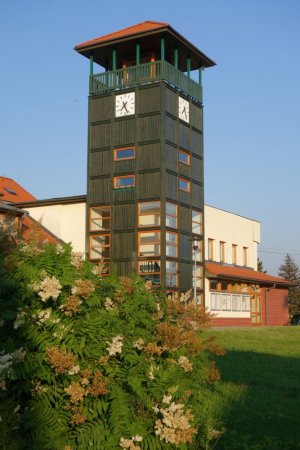
LOOKOUT TOWER IN SOBĚŠOVICE
Built in 2004, a 17 meter-long steel structure covered with wood with an internal steel staircase is currently part of the Commune Office. The 13-meter high roofed lookout tower stretches a wide panorama (Moravian-Silesian Beskids with the dominating Bald Mountain, Smrk and Jaworów, the Silesian Beskids with Czantoria Wielka, the Žermanice Reservoir and the Havířov Mountains). The lookout tower is located at the highest point, just off the main road which passes through the entire village. If someone wants to try climbing the hill, we recommend the path from Dolní Domaslavice. From the Žermanice Reservoir, waiting for us is a forceful, eight-hundred meter climb with a steep slope. On the other side of Žermanice, it’s not so interesting and the climb does not prove such a challenge.
Vyhlídková věž v Soběšovicích; Soběšovice 10, 739 38 Soběšovice; tel. +420 558 404 550; www.sobesovice.cz
ŽERMANICE RESERVOIR
The purpose of the Žermanice reservoir is to supply running water to the companies in the Ostrava region, as well as to improve the water flow under the dam and to produce electricity. Officially, it was put into service on the 8th of November 1958 and it initially supplied water to the new steelworks in Ostrava and paper mill in Vratisim[2]. The water reservoir also serves as a reservoir for the Biocel Paskov Chemical Plant. It is also suitable for recreational purposes, bathing, water sports and fishing. The reservoir has fish - it’s possible to catch traditional carp or bream, but also large pike and zander, tench, eels, perch, chub, nase, grass carp, asp, and in the upper part of the reservoir - trout. The lagoon is a rich recreational area of the Ostrava agglomeration. Around it are numerous private houses and hotels, a campsite and several restaurants. In the immediate area, within 1.95 hectares, there is an abandoned and partially flooded mining quarry with rare flora and fauna[3]. The boundaries of the reservoir are formed by the municipalities of Lučina, Dolní Domaslavice, Soběšovice and Žermanice.
ŽERMANICE QUARRY
Žermanice Quarry is an old quarry of almost two hectares founded in the teschenite deposit, which can be found in the Frýdek-Místek district of the Moravian-Silesian Region. The protected area is managed by the Moravian-Silesian Regional Office. The village is located in the Upper Podbeskidska area, in the Upper Cieszyn, Wyżyna Hornotěrlická region. It is near the north-eastern end of the Žermanice reservoir, where construction materials from the quarry were used in the 1950s. At the bottom of the quarry, there is a wetlands ecosystem with a large surface area of water with various species of plants and animals, some of which are critically endangered or close to extinction. The ecosystem consists of areas of open water and southern mining walls. It has been listed as a natural monument since 1992.
KOTULA WOODEN COTTAGE
The Kotula wooden cottage is a log house in the town of Havířov in the Moravian-Silesian Region. It’s from 1781 and is the oldest preserved element of the original buildings. Kotula was built by a man named Folwarczny, whose name is engraved on the beam at the entrance to the cottage. The cottage was available to visitors from 1955 until 1989, when it was closed and then reopened in 1997 as a branch of the Cieszyn Land Museum. Next to the cottage stands a younger brick barn with a pigsty and windmill. Here can be found a folklore and agricultural exhibition from the turn of the 19th and 20th century.
Kotulova dřevěnka; Hálkova 1445/4, 736 01 Havířov; tel. +420 602 709 731; www.muzeumct.cz/kotulova_drevenka
PODOBORA
The archaeological park in the Chotěbuz commune is one of the newly built parks of its kind - a reconstruction of the Slavic settlement in the Czech Republic. The reconstruction of the fortified town from the mid-eighth to eleventh century was built on a hill surrounded by a wall and a moat, in the same place as an iron age settlement from 800-400 BC. It is here that there are houses and common areas of the Slavic settlement, with examples of clothing, weapons and food of the periods settlement of the Cieszyn Land. Lectures and shows of daily life are presented in clothes of the age, and also show historic events, such as the murder of Prince Wenceslas in the town of Stará Boleslav.
Podobora; Karvinská 455, 735 61 Chotěbuz; tel. +420 552 309 133; www.archeoparkchotebuz.cz
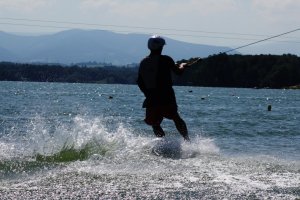
TĚRLICKO SKI&WAKE PARK
The water park is the only sports facility of its kind designed for water skiing, wakeboarding, wakeskating and kneeboarding. From May to September, it is a place of pleasant relaxation associated with classic summer fun. Every year, the building is equipped with new elements. Ski&Wake Park is the only place in the Czech Republic where sports at the highest, European level take place.
Ski&Wake Park; Chatová 102/13, 73542 Těrlicko; tel. +420 608 863 067; www.skiwakepark.cz
HAVÍŘOV CASTLE
The castle in Havířov was built around 1438 and often changed owners in the following years. The last noble owner was the industrialist, David Gutmann. In the 1950s and ‘60s, the “Šumbark Castle” deteriorated and was completely reconstructed in 1997. It currently holds a hotel with a restaurant, a meeting hall of the “city of Havířov” and a small concert hall. The castle currently serves for purely commercial purposes.
Zámek Havířov; K Zámečku 243/2, 736 01 Havířov; +420 596 811 463, www.zamekhavirov.cz
